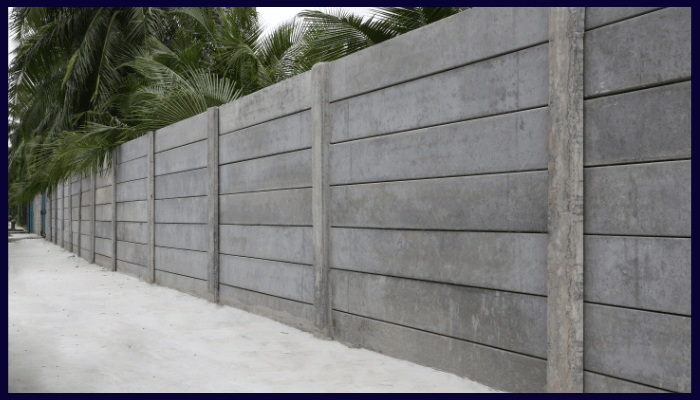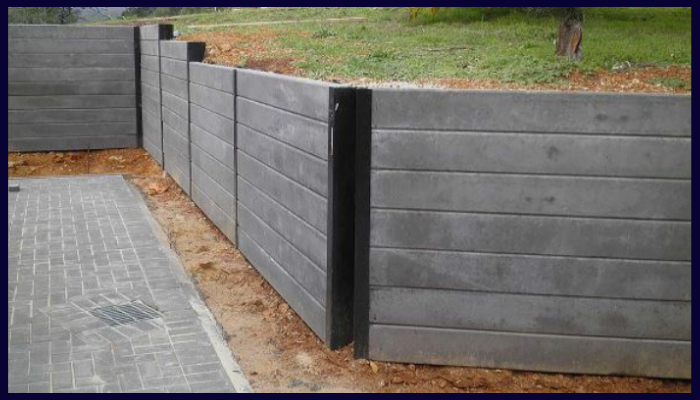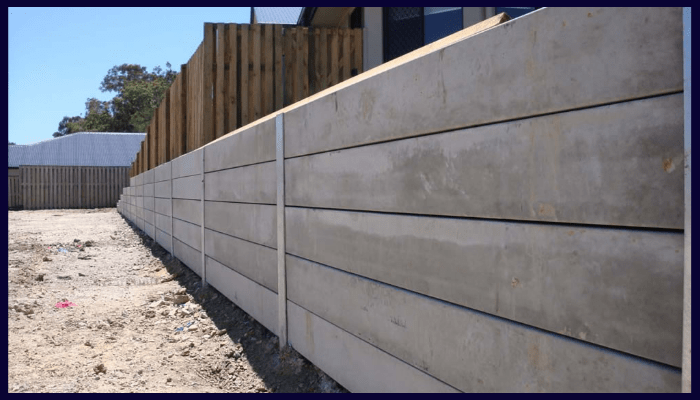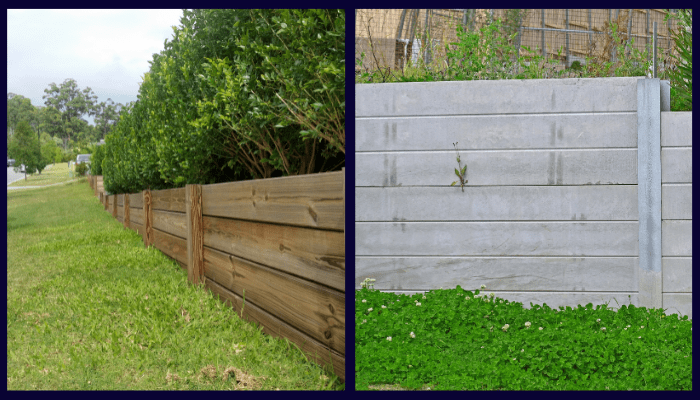Concrete Sleeper Retaining Wall Lifespan: How Long Do They Last in Albury?
Why Does Lifespan Matter for Albury Homeowners?
Why Lifespan Matters for Albury Homeowners
Concrete sleeper retaining wall lifespan is something most Albury homeowners think about, because this structure isn’t just another garden feature.
It's holding up your property, literally. Concrete sleeper retaining walls offer durability and both functional and aesthetic benefits, improving your outdoor space.
Knowing how long your wall will last impacts your budget and your peace of mind during heavy rain.
The lifespan isn’t just about choosing good materials. It’s also about ensuring your investment lasts for decades.
The Impact of Climate and Soil on Retaining Wall Durability
Albury cops some harsh weather. Blazing summers, decent rainfall, plus those reactive clay soils that swell and shrink.
Environmental factors affect your wall in several ways: soil erosion, water pressure behind the structure, and ground movement.
These can all challenge its strength. Concrete sleepers need good drainage systems in local conditions like ours to avoid wall failure.
The actual longevity depends on site conditions, not what's written on the product brochure.
Factors Influencing Longevity: Materials, Installation, and Maintenance
You get what you pay for with retaining walls. Chuck up some basic concrete blocks with no drainage system?
You'll be lucky to get 15 years. Invest in high-quality materials. Use steel posts.
Ensure proper installation by experienced contractors who follow Australian standards.
That wall could easily last 40 years or significantly longer.
Several factors decide if your concrete sleeper retaining project succeeds:
Construction quality.
Proper maintenance schedule.
Correct installation with good techniques from the start.
What Determines the Lifespan of a Concrete Sleeper Retaining Wall?
Key Factors That Significantly Impact Longevity
Want to know what really determines your concrete sleeper retaining wall lifespan?
Start with concrete quality and whether your steel posts have decent rust protection.
Proper construction techniques during installation are key.
Also, factors like your drainage system and soil movement play a role. Plus, it's important to maintain and repair promptly when needed.
Mess up any of these and your wall won't last nearly as long as it should.
These several factors work together to significantly impact how many years you'll get from your investment.
Australian Standards for Durability and Structural Integrity
Your retaining wall needs to meet Australian standards if you want proper durability.
We're talking AS 2870 for soil classification and footings, AS 3600 for concrete structures, and AS/NZS 4680 for galvanised steel posts.
These aren't just suggestions. Every retaining wall project in Albury must follow these steps. This ensures the structural integrity and long-term stability that property owners expect.
Average vs Engineered Lifespan
Typical Lifespan for Standard Installations
Most concrete sleeper retaining walls around Albury last about 15 to 25 years when they're built to standard specs.
That's assuming you've got average quality materials, basic drainage, and reasonable site prep.
What kills walls early?
Blocked drains cause water to collect. Shallow footings can't support weight. Soil erosion washes away support.
Tree roots have been left unchecked. These issues cause wall failure way before the concrete itself wears out.
Maximum Engineered Lifespan (40–50+ Years)
Get everything right and concrete sleepers can last 40 to 50 years, sometimes significantly longer.
We're talking 40 MPa concrete, hot dip galvanised steel posts, footings that go deep enough, and a drainage system that actually works.
Professional installation by experienced contractors who know what they're doing makes all the difference.
Compare that to timber walls that rot after 10 to 20 years or concrete block walls that might give you 30 to 50.
Strong sleeper retaining walls show what good engineering can do.
How Climate and Soil Affect Retaining Wall Longevity
Soil Reactivity and Foundation Movement
Anyone building in Albury knows our clay soils are trouble. They swell when wet, shrink when dry, and that movement puts massive stress on retaining walls.
You need proper geotechnical testing and engineered footings to handle it. Premium materials don’t matter if your foundations shift.
This happens when the soil isn’t assessed correctly. Site conditions here play a vital role in whether your wall stays put.
Temperature, Moisture, and Drainage Challenges
Albury summers are brutal for concrete curing. Pour footings in 40 degree heat without proper curing and you'll get tiny cracks everywhere.
But the bigger problem is water. Without proper drainage systems to handle runoff, water pressure builds up behind your wall.
That hydrostatic pressure is what destroys most retaining structures around here. Managing moisture isn't optional if you want your wall to last.
Managing Soil Erosion and Drainage Pressure
Your drainage system needs to work properly or your wall's doomed.
This means using gravel backfill, geotextile fabric, and perforated pipes to direct water away from the structure.
Skip this stuff to save money and even the best concrete sleeper retaining design will fail early.
Erosion control and drainage aren't extras, they're crucial for getting decades of service from your wall.
Engineering Design and Installation: The Vital Role of Professional Construction
Structural Design and Drainage System Integration
Getting decades from your concrete sleeper retaining wall isn't just about buying good materials. You need smart engineering.
It should mix strong structures with good drainage systems. This ensures long-term stability.
Your drainage system needs:
Gravel packed behind the concrete sleepers.
Weep holes to let water out.
A place for the water to go, so it doesn't wash away your property.
Skip any of these and you're asking for wall failure.
The Importance of Professional Installation
Professional installation makes or breaks your retaining wall project. Experienced contractors who work with certified engineers know the local regulations inside out.
They also understand which projects need council approval based on wall height, load, and proximity to boundaries.
Getting these approvals right from the start prevents costly delays and ensures compliance with Albury’s building requirements.
These things significantly impact whether your wall lasts 15 years or 50. Getting it installed correctly the first time costs less than fixing disasters later.
Maintenance, Inspections, and Extending Service Life
Proper Maintenance Practices
Your concrete sleeper retaining wall needs looking after if you want it to last.
Remove dirt and moss each year.
Reseal the concrete when it looks worn.
Keep plants away from the surface.
Tree roots are killers for retaining walls. Stop rot, pests and erosion starting at the base and you'll significantly extend the lifespan. Proper maintenance isn't hard, it just needs doing regularly.
Early Signs of Damage and How to Prevent Wall Failure
Watch for walls starting to lean, rust marks on steel posts or concrete, and water not draining properly.
Catch these early and prompt repairs will save your wall. Leave them and you'll need complete replacement.
Get professional eyes on it when something looks wrong. Early fixes stop big bills and keep structures strong. They fix small issues before they lead to wall failures.
Comparing Material Options and Long-term Value
Concrete vs Timber vs Block Retaining Walls
Concrete Sleeper Retaining Walls vs Timber - Timber walls might be cheaper upfront but they rot after 10 to 20 years, especially with our wet winters.
Termites and other pests love them too. Concrete block walls can last 30 to 50 years.
However, installation costs are high, and they're tough to install on slopes. Concrete sleeper retaining walls last 40 to 50 years if built correctly.
They also look great in your garden. They also look great in your garden, enhancing your landscape while handling our tough conditions, making them ideal for Albury properties that need long-term stability and low maintenance.
The Economic Value of Long-term Stability
Do the maths on total costs over 30 years and quality concrete sleepers win every time.
Sure, timber's cheaper today, but replacing it twice while your neighbour's concrete wall stands strong?
That's where you lose money. Factor in lower maintenance, no rot or pest problems, and the aesthetic benefits for your property value.
Using high-quality materials and expert advice in construction ensures your wall stays stable for the long term.
This approach can save you money. Match your installation to site conditions and you've got valuable insights into real value.
Final Thoughts
To get your retaining wall right, focus on proper installation and drainage.
This will help it handle Albury's soil and weather. Concrete sleeper retaining walls offer strength and beauty.
They transform problem slopes into usable outdoor areas, keeping everything stable.
Quality materials, professional installation and regular maintenance deliver walls that last decades.
Not just years. Knowing how design, materials, and local conditions fit together helps homeowners build lasting retaining walls.
These walls can enhance property value for generations. It's crucial to get it right first time.
Frequently Asked Questions
-
Standard concrete sleeper retaining walls last 15 to 25 years around Albury. But get them engineered properly with high quality materials and proper drainage systems? You're looking at 50 years plus. The durability vary based on several factors including installation quality.
-
Reactive clay soils are the big one, plus whether your footings are done right. Your drainage system plays a vital role too. Use quality materials, and these factors will work together. This way, you'll greatly extend the lifespan of your retaining walls.
-
Check your wall regularly, reseal the concrete when it needs it, remove dirt buildup and fix drainage problems fast. Keep vegetation away from the structure. These simple maintenance steps enhance longevity and prevent costly repairs down the track.
-
Our reactive soils move constantly, causing cracks and shifting. Soil erosion removes support. Poor drainage builds up water pressure. This pressure can damage concrete sleepers and steel posts. These site conditions significantly impact whether you get 15 years or 50 from your wall.
-
Because nobody wants to rebuild their retaining wall every decade. Investing in proper construction and materials means your wall lasts for generations. Because nobody wants to rebuild their retaining wall every decade, investing in proper construction and materials ensures your concrete sleeper retaining wall lifespan extends for generations.
Greg Hair, owner of Slide Living, has over a decade of experience in delivering high-quality landscaping and outdoor living solutions across Albury-Wodonga and surrounding regions.
Known for his attention to detail and great customer care, Greg has transformed hundreds of properties, specialising in everything from fencing, decking and home irrigation.
SLIDE Living is fully licensed and insured, ensuring top-notch workmanship and customer satisfaction on every project.







